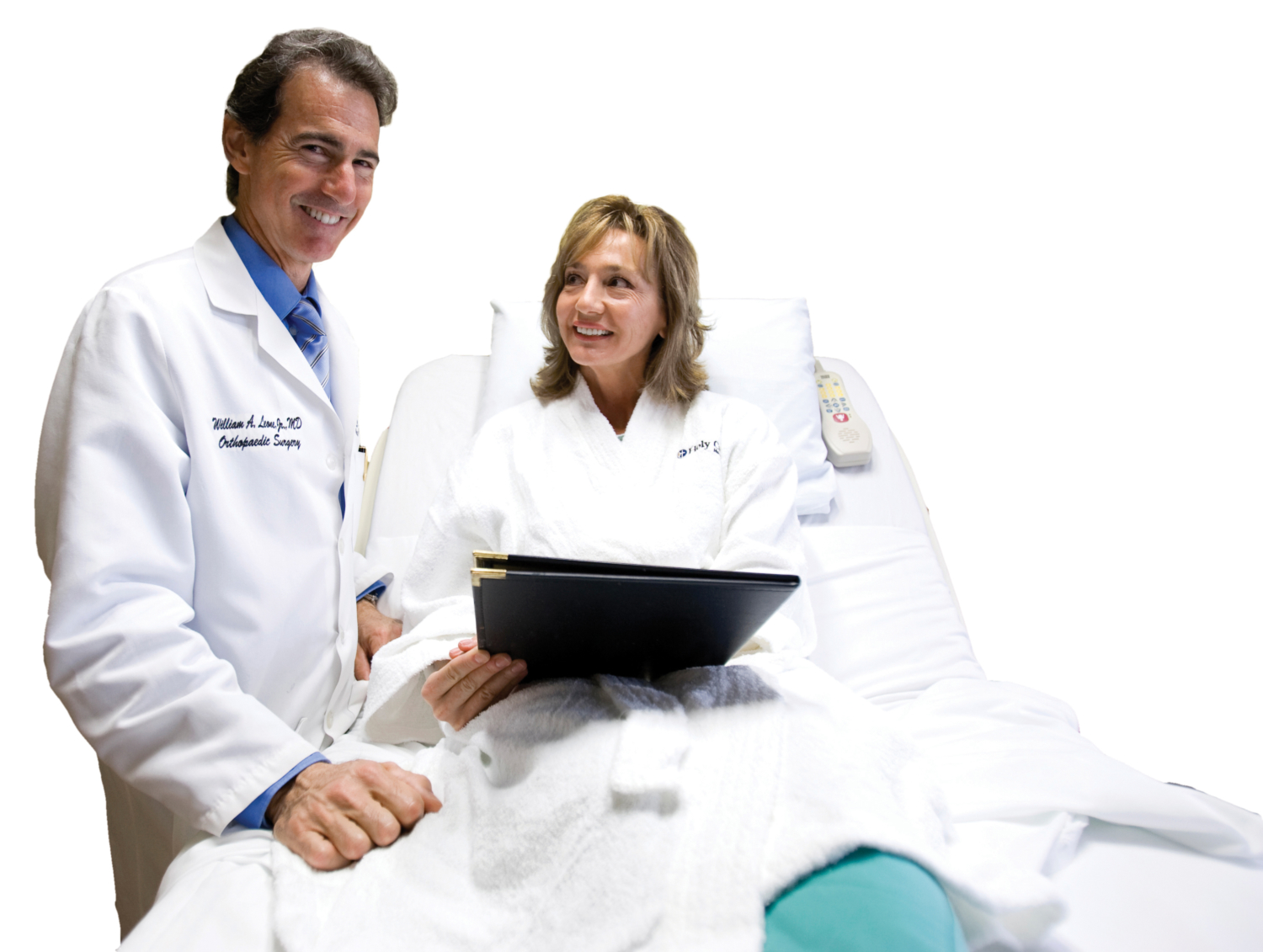Total Hip or Total Knee Replacement
The Day of Surgery
Most patients get out of bed and walk with supervision just hours after their surgery. This is wonderfully therapeutic. Getting out of bed so quickly after surgery helps your circulation, protects your skin against pressure sores and results in an “I can do it” attitude and confidence that results in a faster recovery. Most patients then go home later this day.
One Day After Surgery
For those patients who did not go home the day of their surgery, you will be assisted out of bed for breakfast, changing out of a hospital gown into your own clothes, and walking to the bathroom to wash up for the day. Dr. Leone and his team will visit with you later that morning.
If you had a total hip replacement, Dr. Leone and his team will review with you your surgery and your post-operative plan. Most patients are not restricted in their movements and are encouraged to move freely within their comfort. Occasionally different instructions are given.
If you had a total knee replacement, Dr Leone and his team will also give you specific instructions including to place a rolled sheet under your lower leg just above you heel when in bed, to encourage full extension of your knee and exercises to improve flexion and strengthen your muscles. You will also be encouraged to continue to use the special cold water sleeve in bed or sitting to decrease pain and swelling.
You will receive physical therapy and occupational therapy, practicing standing, sitting, walking, getting in and out of bed, going up and down steps and even getting into and out of a car. You will be taught specific exercises to strengthen your leg and improve motion.
Instruction will be given on how to use a walker and then progress to a cane or other ambulatory device when appropriate, with the goal of walking device-free as soon as possible. The physical therapist also will provide instructions in the use of reachers and sock aids, as needed.
You will attend one or two therapy sessions and a total joint class and then go home later that day. Occasionally, patients will stay in the hospital an additional one or two days, depending on their specific circumstances and needs.
Before you leave the hospital, we will schedule an appointment for you to come to our office two weeks after your surgery for suture removal. Your plan for continued physical therapy either at home or as an outpatient will be confirmed and any meds or prescriptions that you need will be provided. You’ll be given very specific instructions on caring for your surgical dressing, when to shower and arrangements will be made for any any physical supplies you may need at home.
Partial Knee Replacement
When you are awake and comfortable, you will be transferred from the Post Anesthesia Care Unit (PACU) to a different area called Post-Anesthesia Phase II. If you have family or friends waiting, they are welcome to join you here. You will be visited by a physical therapist and can go home when you can walk, eat, and go to the bathroom. Our staff will help you make arrangements for a walker or crutches for going home. Most patients do not use these aids very long after going home and many time my office will loan you one for the few days they are needed.
Leaving The Hospital
You will be discharged from the hospital with instructions and medication, as needed. Our staff will call you a day or two after your surgery to confirm that you are doing well and answer any questions that you may have.
While most patients prefer to go home rather than to go to another facility, some patients may need to be discharged to a rehabilitation facility. In that case, we will carefully review the discharge plan with you and provide the rehabilitation facility with instructions, including any medicines you are taking, your physical therapy protocol and when to come back to our office.
General guidelines
- Continue your exercises faithfully to reduce pain and swelling and improve motion.
- Elevate your legs three times each day for 45 minutes. You may stop when you no longer see any ankle or lower leg swelling.
- If you had a hip replacement then applying an ice pack will give you pain relief and decrease swelling. Many patients continue to do this for several weeks after their surgery.
- If you had a total or partial knee replacement, when in bed or sitting with you leg in extension, place a roll of sheets under your lower leg just above your heel to promote knee extension until you can fully extend comfortably. Continue to use the cold water pad to decrease pain and swelling in bed or when resting.
- If you had a total hip replacement, you may shower when you are home if your aquacel dressing is dry and sealed. Simply blot dry after your shower.
- If you had a knee replacement, we ask that you wait 4 days before showering and when your surgical wound is sealed and dry. Your incision is covered with steri-stips. Simply blot the incision and steri-strips dry when done showering.
We encourage pool walking, aquatic exercises and swimming. Usually this starts 2 weeks after surgery once your suture is removed.
Finding a physical therapist
We work with many qualified physical therapists and continue to develop new relationships in the community. Because the environment is so fluid, however, we no longer provide a list of preferred providers. Rest assured, our staff will help you navigate these decisions based on our most recent and best experience.




